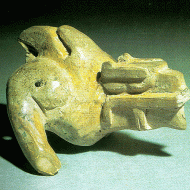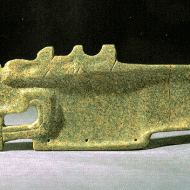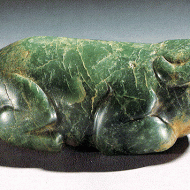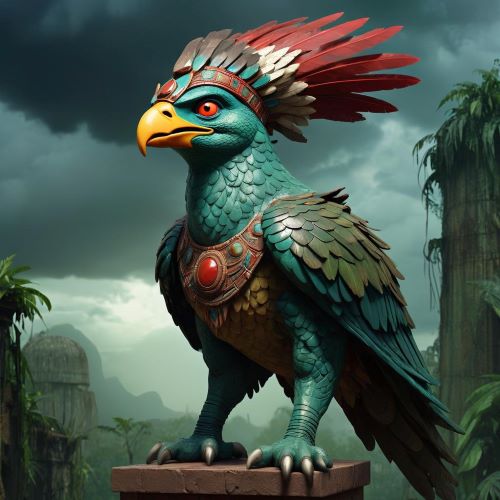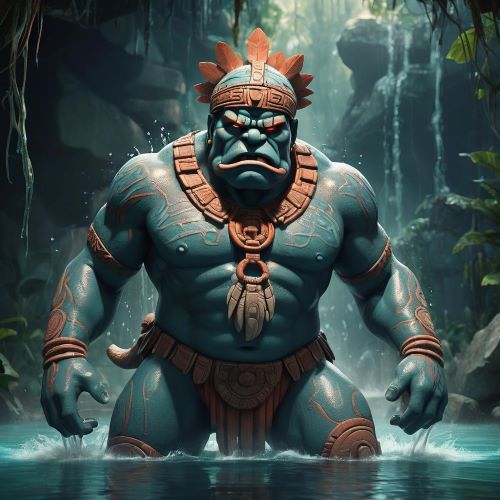Olmec Dragon : The Earth Monster
Listen
At a glance
| Description | |
|---|---|
| Origin | Olmec Mythology |
| Classification | Gods |
| Family Members | N/A |
| Region | Mexico |
| Associated With | N/A |
Olmec Dragon
Introduction
The Olmec Dragon is a remarkable figure in Mesoamerican mythology, originating from the Olmec civilization that flourished in southern Mexico between 1200 BCE and 400 BCE. This mythical entity holds profound mystical significance and embodies rich cultural symbolism. The Olmec Dragon, also known as the Earth Monster, was a central deity in the Olmec belief system, represented prominently in their art and likely pivotal in their rituals. Unlike the dragons of European folklore, this deity assumed the form of a crocodile-like creature with human and possibly eagle or jaguar features. The Olmec people revered the Olmec Dragon as a primary god, attributing the well-being of their society to its favor.
Physical Traits
Unlike the fire-breathing dragons of European mythology, the Olmec Dragon draws inspiration directly from the natural world. Its primary form resembles that of a crocodile, featuring a long snout, sharp fangs, and a robust body. However, Olmec artisans infused complexity into their representations. The Dragon often displays flame-like eyebrows, a bulbous nose, and a forked tongue, alluding to its connection with elemental forces. Some depictions even incorporate features reminiscent of jaguars or eagles, symbolizing its ties to revered animals.
One of the most captivating elements of the Olmec Dragon’s portrayal is its gaping mouth. Often depicted wide open, this mouth symbolizes caves, believed to be gateways to the underworld and sources of life-giving water. This association with caves may have influenced the Olmec preference for using cave walls as a canvas for their art. In Olmec art and iconography, the Olmec Dragon emerges as a fusion of serpent-like attributes and unique dragon-esque qualities. Its representation features a sinuous body and a serpentine face, often embellished with intricate headdresses or ceremonial adornments, reflecting the mythical significance and ceremonial role of this enigmatic creature.
Family
The Olmec Dragon is among the enigmatic androgynous deities of the Olmec pantheon, a civilization that lacked a written language, relying on oral tradition to preserve its mythology. Consequently, specific details regarding the Olmec Dragon’s familial relationships remain elusive. Unlike later Mesoamerican civilizations with well-defined pantheons, the Olmec belief system retains an air of mystery. While archaeologists have yet to uncover explicit evidence of familial ties involving the Olmec Dragon, other recurring supernatural beings frequently accompany it in Olmec artwork.
These companions include the Maize God, symbolizing agriculture, the Were-Jaguar, a deity associated with powerful rain, and the Feathered Serpent, a precursor to the renowned Quetzalcoatl of Aztec lore. It’s conceivable that these entities collectively formed a loose pantheon, with the Olmec Dragon serving as a central figure in their cosmology.
Other Names
The Olmec Dragon, alternatively recognized as the Earth Monster, lacks a specific name in the absence of written records from the Olmec civilization. Scholars and researchers have bestowed various titles upon this mystical entity based on its attributes and presumed functions. The designation “Earth Monster” highlights its association with the land and fertility, embodying the vital forces of the natural world.
Some scholars also identify a “Personified Earth Cave” based on its depiction with cave-like openings, further emphasizing its significance in Olmec cosmology. Across different Mesoamerican cultures, the Olmec Dragon adopts diverse names that underscore its widespread cultural impact. In Aztec tradition, it may be known as Xiuhcoatl, representing a fiery serpent. Among the Zapotec and Mixtec mythologies, it might be referred to as Cocijo, symbolizing a rain and lightning deity often depicted with serpentine attributes. These alternative names highlight the enduring legacy and profound cultural significance of the Olmec Dragon beyond its original context.
Powers and Abilities
The Olmec Dragon was revered as the patron deity of the elite and held responsibility for crucial aspects of existence, including earth, water, fire, and agricultural fertility. This extraordinary creature symbolized the very essence of the earth, embodying the fertile ground that sustained Olmec civilization. Beyond its fearsome appearance, the Olmec Dragon was perceived as a life-giving force, drawing associations with crocodiles, which symbolize water and likely influenced its connection to rain and vitalizing properties. Moreover, its flame-like attributes hinted at roles in creation and transformation, reflecting the perpetual changes of the earth.
The Olmec Dragon assumed a role as a guardian of the ruling class, with its association with caves—regarded as gateways to the spirit world—suggesting a link to rulership and the transfer of power. Its influence transcended the physical realm, encompassing the unseen dimensions and underscoring its pivotal role in Olmec society.
Legends attributed the Olmec Dragon with formidable powers, aligning it with elemental forces and supernatural abilities. Revered as a symbol of cosmic order, the dragon wielded authority over natural phenomena such as rain, fire, and fertility. Its significance extended beyond mythological narratives, reflecting the Olmec people’s profound comprehension of the interconnectedness of the universe and their deep reverence for divine forces.
Modern Day Influence
The Olmec Dragon’s influence transcends ancient Mesoamerica, inspiring modern artists and writers alike. Contemporary sculptures and paintings often depict the Dragon, blending its features with elements of traditional European dragon imagery. In video games and fantasy literature, the Olmec Dragon takes on new roles as a formidable guardian or fearsome adversary, captivating audiences with its mythical allure.
Moreover, the study of Mesoamerican mythology benefits greatly from understanding the Olmec Dragon. Insights gleaned from this ancient deity shed light on the development of subsequent Mesoamerican pantheons. Deities like the Aztec Cipactli, associated with crocodiles, and Xiuhtecuhtli, the fire god, likely trace their origins to the Olmec Dragon, demonstrating the enduring impact of Olmec culture on later civilizations.
While much about the Olmec Dragon remains veiled in mystery due to the absence of written records, its enduring imagery testifies to the creative prowess and profound symbolism of the Olmec civilization. The Dragon’s composite form—melding attributes of crocodiles, jaguars, and humans—symbolizes the elemental forces that shaped the Olmec world. This enduring legacy continues to captivate and intrigue, offering a tantalizing glimpse into a lost civilization and the potent deities they venerated.
The Olmec civilization’s cultural and artistic legacy, including the legacy of the Olmec Dragon, endures through ongoing exploration by researchers. Despite the lack of written records, scholars glean insights from sculptures, paintings, and other artistic representations scattered across the former Olmec empire. The Olmec Dragon’s influence as a precursor to numerous Aztec and Mayan deities underscores its profound impact on the trajectory of Mesoamerican mythology and religious beliefs.
Related Images
Frequently Asked Questions
What is Olmec Dragon God of?
The Olmec Dragon God, a complex deity depicted as a crocodile-like creature with flame eyebrows, was associated with multiple powerful domains: earth, water, fire, and the otherworldly. Considered the patron of the elite and possibly the earth’s creator, this God may have influenced the development of later Mesoamerican deities like Quetzalcoatl.
Who are the 8 gods of the Olmec?
The Olmec worshipped eight gods, each with their own unique domain: the earth-ruling Olmec Dragon, the celestial Bird Monster, the fearsome Fish Monster, the enigmatic Banded-Eye God, the life-giving Maize God, the rain-bringing Rain Spirit, the transformative Were-Jaguar, and the powerful Feathered Serpent. These deities represent the diverse spectrum of the Olmec’s spiritual beliefs, encompassing natural forces, life-sustaining elements, and the mysteries of the universe.
What was the Olmec jaguar God?
The Olmec jaguar God, a powerful hybrid of human and jaguar, held a complex role in their mythology. He likely represented shamanism and transformation, guiding souls through the underworld. His strength and ferocity also linked him to rulership and earthly power, possibly influencing agricultural abundance. While once considered the singular deity, the jaguar God is now believed to be one of several worshipped by the Olmec, leaving his full significance open to ongoing exploration.
What animal was Worshipped by the Olmecs?
The jaguar was the primary animal worshipped by the Olmecs. However, they didn’t simply revere it in its natural form. Instead, they worshipped it as a were-jaguar: a powerful hybrid figure combining human and jaguar features. This representation embodied the jaguar’s strength, ferocity, and connection to the natural world, making it a significant symbol in their mythology.
Is Olmec a religion?
While the Olmecs lacked a formal religion as we know it, their beliefs were intricate and deeply intertwined with their cultural life. Evidence like artwork, ceremonial sites, and shamanism points towards a complex world of deities, rituals, and a three-tiered cosmology. Though limited written records and regional variations complicate our understanding, the Olmecs undoubtedly possessed a sophisticated belief system that laid the foundation for later Mesoamerican religions.

